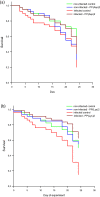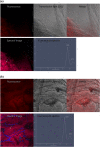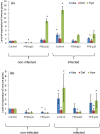Effect of amide protoporphyrin derivatives on immune response in Apis mellifera
- PMID: 36002552
- PMCID: PMC9402574
- DOI: 10.1038/s41598-022-18534-9
Effect of amide protoporphyrin derivatives on immune response in Apis mellifera
Abstract
The intracellular microsporidian parasite Nosema ceranae is known to compromise bee health by induction of energetic stress and downregulation of the immune system. Porphyrins are candidate therapeutic agents for controlling Nosema infection without adverse effects on honeybees. In the present work, the impact of two protoporphyrin IX derivatives, i.e. PP[Asp]2 and PP[Lys]2, on Apis mellifera humoral immune response has been investigated in laboratory conditions in non-infected and N. ceranae-infected honeybees. Fluorescence spectroscopy analysis of hemolymph showed for the first time that porphyrin molecules penetrate into the hemocoel of honeybees. Phenoloxidase (PO) activity and the expression of genes encoding antimicrobial peptides (AMPs: abaecin, defensin, and hymenoptaecin) were assessed. Porphyrins significantly increased the phenoloxidase activity in healthy honeybees but did not increase the expression of AMP genes. Compared with the control bees, the hemolymph of non-infected bees treated with porphyrins had an 11.3- and 6.1-fold higher level of PO activity after the 24- and 48-h porphyrin administration, respectively. Notably, there was a significant inverse correlation between the PO activity and the AMP gene expression level (r = - 0.61696, p = 0.0143). The PO activity profile in the infected bees was completely opposite to that in the healthy bees (r = - 0.5118, p = 0.000), which was related to the changing load of N. ceranae spores in the porphyrin treated-bees. On day 12 post-infection, the spore loads in the infected porphyrin-fed individuals significantly decreased by 74%, compared with the control bees. Our findings show involvement of the honeybee immune system in the porphyrin-based control of Nosema infection. This allows the infected bees to improve their lifespan considerably by choosing an optimal PO activity/AMP expression variant to cope with the varying level of N. ceranae infection.
© 2022. The Author(s).
Conflict of interest statement
The authors declare no competing interests.
Figures







Similar articles
-
Are commercial probiotics and prebiotics effective in the treatment and prevention of honeybee nosemosis C?Parasitol Res. 2016 Jan;115(1):397-406. doi: 10.1007/s00436-015-4761-z. Epub 2015 Oct 6. Parasitol Res. 2016. PMID: 26437644 Free PMC article.
-
The pathological effects of a Nosema ceranae infection in the giant honey bee, Apis dorsata Fabricius, 1793.J Invertebr Pathol. 2021 Oct;185:107672. doi: 10.1016/j.jip.2021.107672. Epub 2021 Sep 29. J Invertebr Pathol. 2021. PMID: 34597621
-
Silencing the Honey Bee (Apis mellifera) Naked Cuticle Gene (nkd) Improves Host Immune Function and Reduces Nosema ceranae Infections.Appl Environ Microbiol. 2016 Oct 27;82(22):6779-6787. doi: 10.1128/AEM.02105-16. Print 2016 Nov 15. Appl Environ Microbiol. 2016. PMID: 27613683 Free PMC article.
-
Spore load and immune response of honey bees naturally infected by Nosema ceranae.Parasitol Res. 2017 Dec;116(12):3265-3274. doi: 10.1007/s00436-017-5630-8. Epub 2017 Nov 6. Parasitol Res. 2017. PMID: 29104999
-
Nosema ceranae in European honey bees (Apis mellifera).J Invertebr Pathol. 2010 Jan;103 Suppl 1:S73-9. doi: 10.1016/j.jip.2009.06.017. Epub 2009 Nov 11. J Invertebr Pathol. 2010. PMID: 19909977 Review.
Cited by
-
Overlapping exposure effects of pathogen and dimethoate on honeybee (Apis mellifera Linnaeus) metabolic rate and longevity.Front Physiol. 2023 Jun 6;14:1198070. doi: 10.3389/fphys.2023.1198070. eCollection 2023. Front Physiol. 2023. PMID: 37346484 Free PMC article.
-
Advanced Research on Biological Properties-A Study on the Activity of the Apis mellifera Antioxidant System and the Crystallographic and Spectroscopic Properties of 7-Diethylamino-4-hydroxycoumarin.Int J Mol Sci. 2025 Jul 21;26(14):7015. doi: 10.3390/ijms26147015. Int J Mol Sci. 2025. PMID: 40725260 Free PMC article.
-
Liposome-based RNAi delivery in honeybee for inhibiting parasite Nosema ceranae.Synth Syst Biotechnol. 2024 Jul 18;9(4):853-860. doi: 10.1016/j.synbio.2024.07.003. eCollection 2024 Dec. Synth Syst Biotechnol. 2024. PMID: 39139857 Free PMC article.
-
Chinese sacbrood virus mediates m6A modification to target and suppress the expression of hemolymph maintenance gene AF9, exacerbating bee infections.J Virol. 2025 Mar 18;99(3):e0211724. doi: 10.1128/jvi.02117-24. Epub 2025 Feb 3. J Virol. 2025. PMID: 39898642 Free PMC article.
-
Changes in enzymatic activity and oxidative stress in honeybees kept in the apiary and laboratory conditions during the course of nosemosis.PLoS One. 2025 Jan 15;20(1):e0317384. doi: 10.1371/journal.pone.0317384. eCollection 2025. PLoS One. 2025. PMID: 39813262 Free PMC article.
References
-
- Sinpoo C, Paxton RJ, Disayathanoowat T, Krongdang S, Chantawannakul P. Impact of Nosema ceranae and Nosema apis on individual worker bees of the two host species (Apis cerana and Apis mellifera) and regulation of host immune response. J. Insect Physiol. 2018;105:1–8. doi: 10.1016/j.jinsphys.2017.12.010. - DOI - PubMed
Publication types
MeSH terms
Substances
LinkOut - more resources
Full Text Sources
Miscellaneous

